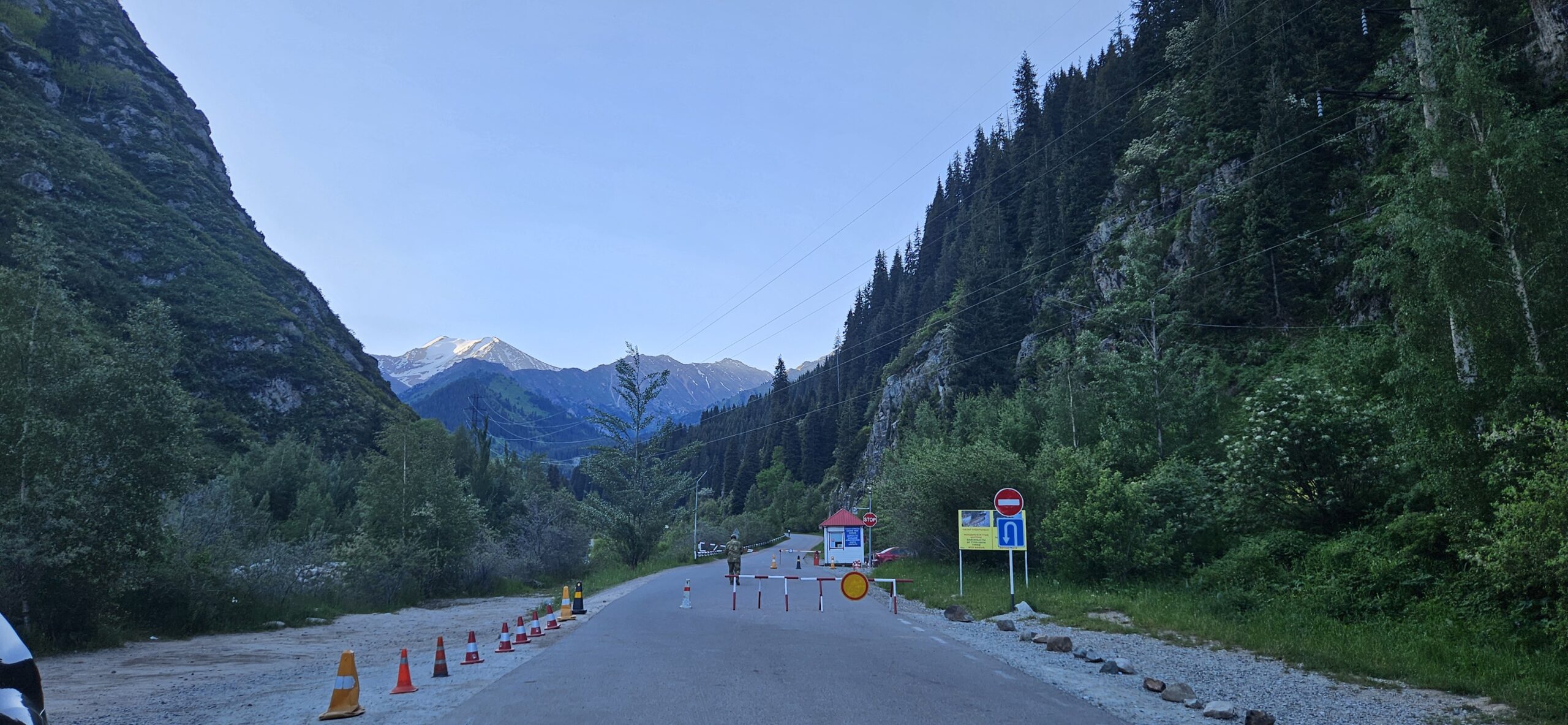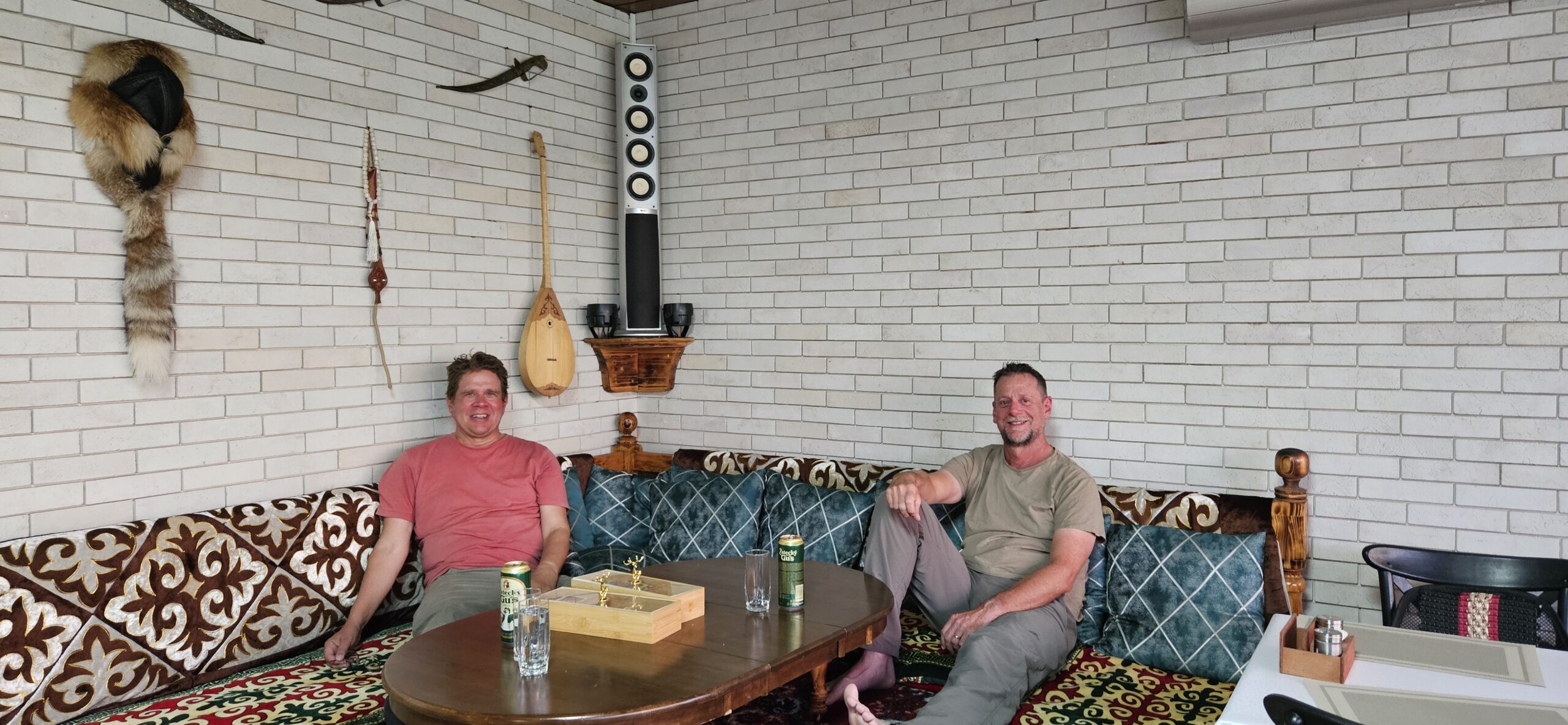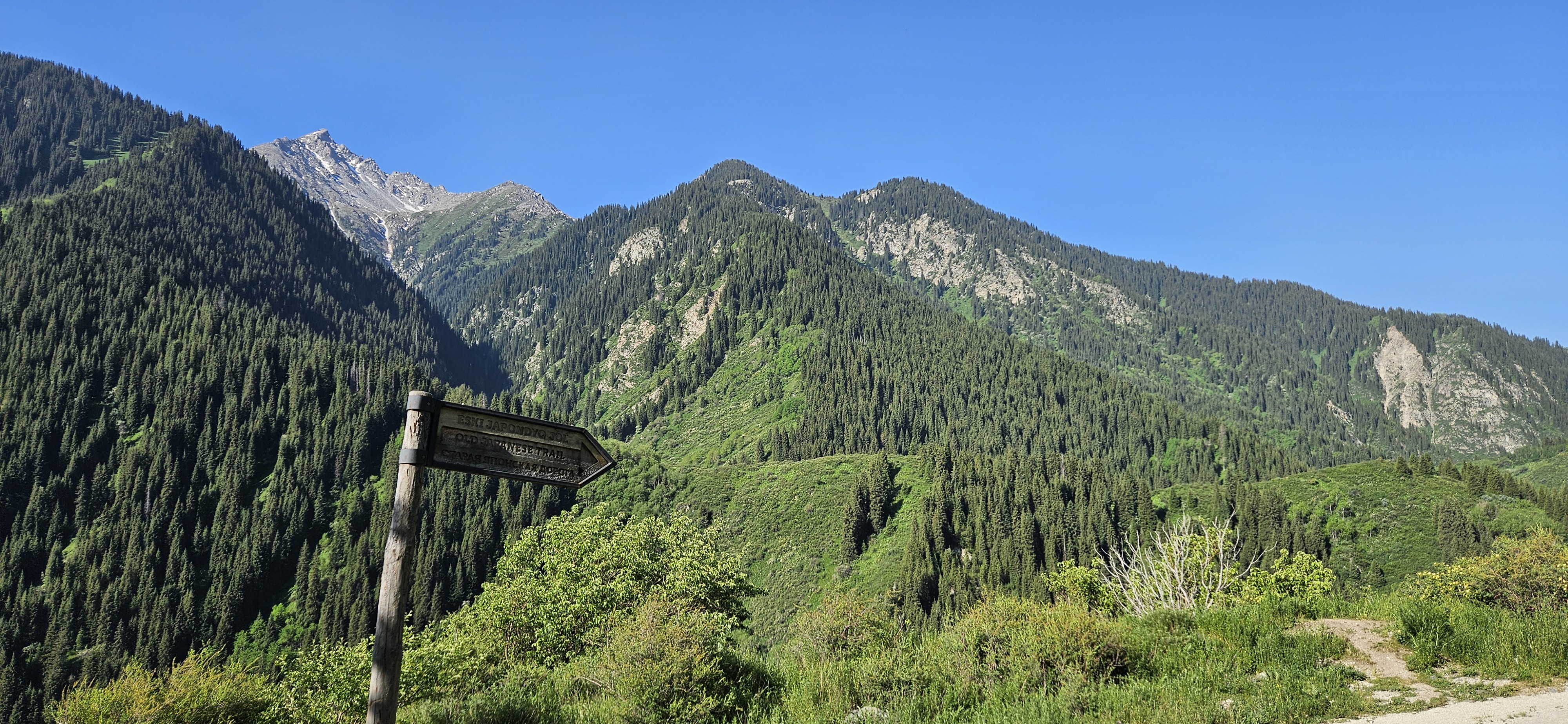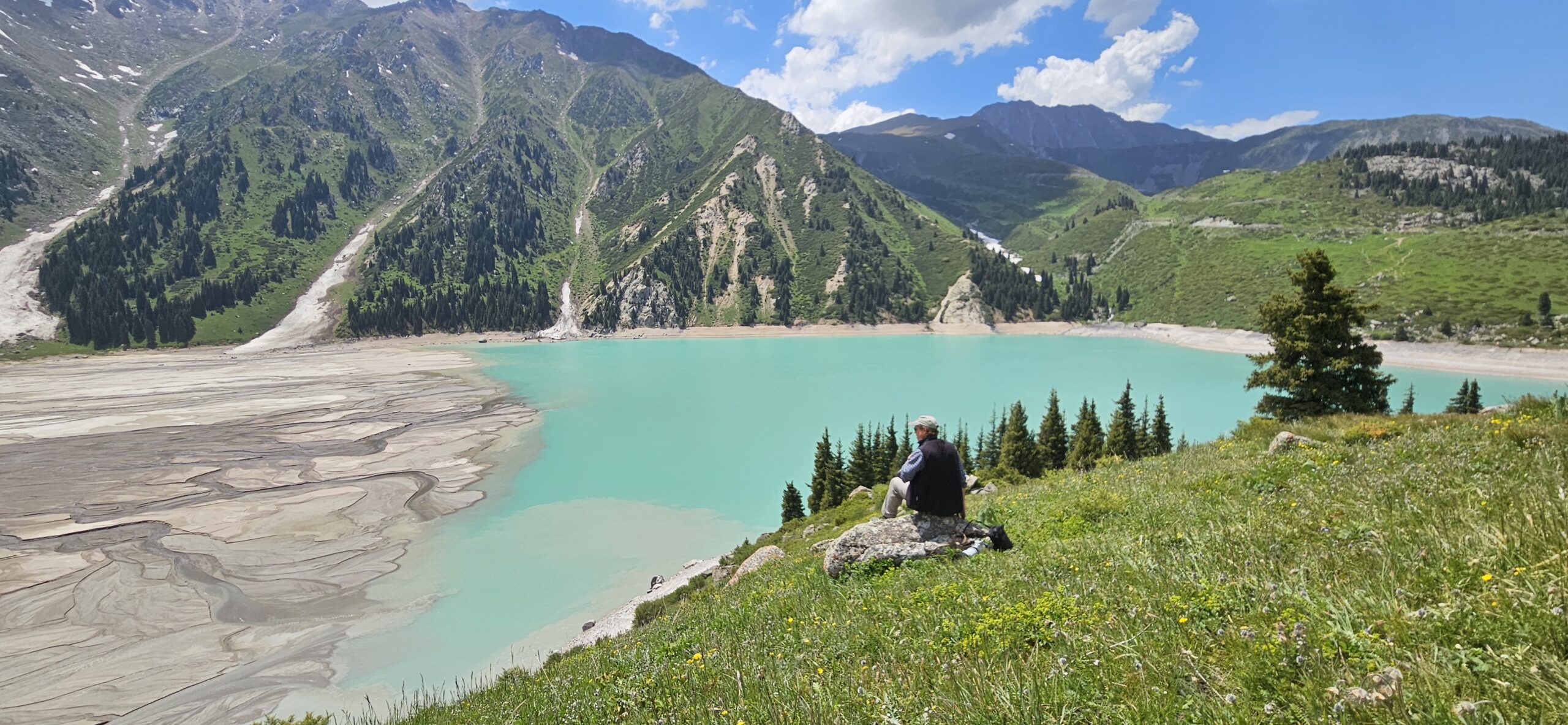It did not escape my attention in moving to Abu Dhabi in September 2023, that UAE is a jumping off spot for a range of amazing birding destinations. In my first 9 months in the new job I was very busy settling in to a new life, and running the department I’d been recruited to head. On weekends when it was not too hot, I birded around Abu Dhabi with new friends Ted, Simon, Des and Oscar, guys who have been in the region for a long time, know the gen, and have each seen more birds than most in UAE and Middle East; they very generously “adopted” me and took me to various sites within an hour or two of Abu Dhabi and Dubai such as Al Qudra, Maha and Hameem Beach. But I only rarely managed to take advantage of the wider travel opportunities, for example my cheeky trip to NW India, in December (blog here).
As well as accessibility to Africa and India, UAE is well connected to several amazing places in Central Asia that seemed ripe for a spring visit, especially the former soviet states like Georgia, Armenia, and the ‘Stans, notably Uzbekistan and Kazakhstan (the list goes on). These countries are filled with great birds in diverse habitats, with culturally rich cities and towns that were historically a melting pot where east met west along the silk road.
In terms of time, I could only afford a weekend, but I was determined to get somewhere a bit cooler and bird-rich before the end of the academic year. Reading trip reports and the itineraries of longer “Central Asia extravaganzas”, I worked out that a weekend trip to Almaty in the south of Kazakhstan could yield some quality lifers in amazing mountain scenery, with flights from Abu Dhabi ideally timed for a weekend assault. It came highly recommended by Oscar and Simon who had birded there before. I was also able to get various gen from pro-guides James Eaton and Nick Upton, both of whom had led tours there in May this year (thanks guys!). But their advice came with a problematic caveat: for the last few years the road up to the best birding areas above Big Almaty Lake has been closed for upgrades. Although as far as we could tell, the upgrades are more-or-less complete, the local authorities have decided to continue to restrict car traffic along the final highest several km, which rise from 2500m to the lake and right up to 3400m at an old Russian cosmonaut station. I would need a way to get up there, or resign to missing several of the key targets.

Despite the risks of not being able to bird some of the best areas, Ted Burkett — fellow birder, fellow ex-pat academic and fellow “bachelor” — was keen to join me. We both reasoned it was short and cheap and we’d have some good birding whatever, so definitely worth the risk. Consequently, we booked Wizz Air 5W 7077 from Zayed International that left early afternoon on Friday (when the universities have a half-day) and returned late Sunday (in fact early hours of Monday), perfectly timed for two full days of birding and no need to eat into annual leave.
That’s not to say we didn’t explore all options for the high altitude habitat and species. One option we considered for getting up to the Kosmos Station was to book a local guide, whose contact details we obtained from a Dubai-based birder who’d recently visited the area. But Ted’s enquiries led to a quote of a staggering US$835 each, with one day up at the Kosmos station. Maybe when absorbed into a big trip or split across more participants, that kind of dosh is less noticeable, but it undermined our idea of a cheap trip and for that price we could afford multiple further weekends in the future.
Instead, I formed a couple of other plans to try to get some or all of the high altitude species. One possibility, suggested by James, was to hire e-bikes (actually more like e-motorbikes, as we found out), which are allowed beyond the check-points that stop cars. We called this Plan A. Another was to bird a different area, Shymbulak, accessible by ski-lift that runs in the summer, and a place Nick had blogged about in 2019 (link). This was Plan B, but with the intention of activating on day 2 if Plan A failed. But before we had to enact either plan, Ted pulled off a master-stroke. His web research came across a trekking company advertising walking on Big Almaty, the 3680m mountain that towers over the city, and exactly where we needed to be birding. Accustomed to taking taking walkers and climbers, year-round, for all-day treks and camping in the high mountains, they are not birders, and apparently had never been out with birders anywhere, but they said they’d be able to get us to the Kosmos Station. This was all we needed! For a full day with a driver and translator, it would be US$300 — 150 each. It was worth the risk!
After a fairly full morning of online meetings and email I rendezvoused with Ted late morning in Terminal A, a mere 10 minutes’ cab-ride from my apartment, and by 6pm we had landed in Almaty, admiring the wall of snow-capped mountains that forms the backdrop to the city. Like many in the west, my preconceptions about Kazakhstan were shamefully formed from watching Borat. But these were rapidly disabused as we breezed through a shiny, new terminal (we discovered that it had opened earlier the same week, so we were among the first to be using it), into a Hertz rental car, and drove across a surprisingly modern and western city to the foothills. I’m not really sure why I was surprised. If I’d done my homework I would have known that Kazakhstan is the richest and largest of these Central Asian former Soviet republics (in fact 9th largest country by landmass in the world), sustained by oil and mining. I was also taken aback with the appearance of many of the locals, finding it odd to hear people with oriental features speaking Russian, a genetic background dating from Mongol occupation under the great warrior Genghis Khan in the 13th century.
Most visiting birders stay at a place called Alpen Rose, high up towards Big Almaty Lake on the edge of the National Park (it is higher than the main road-block after the visitor centre, and presumably a valid reservation gets you through that first roadblock). When I called to make a reservation there was noone who could speak English, so I asked a Russian colleague to call them for me. But he discovered they had no availability for us. Instead I was able to book via email the very lovely Discovery Guest House, on the outskirts of Almaty close to the road into the park. This was a personal recommendation from James Eaton, and we understood why. It may not be as conveniently located as Alpen Rose, but the owners speak excellent English, and were wonderfully accommodating. We were made to feel at home, and nothing was too much trouble, including having a delicious dinner and cold beers ready for us when we arrived late on Friday, and ensuring breakfast was ready at silly-o’clock so we could get out birding in the early hours of the day. Highly recommended.
We had arranged to be picked up at 5.30am, but in retrospect I should have paid more attention to actual daybreak and sunset times. At 43 degrees north, and with no daylight savings, in early June dawn is before 4am. Eek! As we weaved our way at breakneck speed in the trekker’s 4wd, he and his translator explained that we would need to change vehicle. It was not clear why until we pulled up just above the new dam at a police roadblock, parked, and then walked about 500m up the road around a bend out of sight of the policeman. There waiting for us out of sight of the guard, was another vehicle. Evidently the way the trekking company manages access is via a friend who lives and works up near the lake, and supplements his meagre income by moonlighting as a driver in the excluded zone.

We now drove higher and higher, past the lake, through a military checkpoint (that our guys clearly had permission for), past the astronomical observatory and above the tree-line into gorgeous alpine meadows. A few passerines flashed across the road, including my first lifers, Fire-fronted Serin and Altai Accentor. The views of these birds through the windscreen were a bit shit, but we were anxious to get as high as possible as quickly as possible so we didn’t stop, assuming we’d see more. In retrospect a mistake: although we saw further Serins, this was the only Altai Accentor we saw all day.
The old Russian vehicle we were now in was struggling a bit with the 15-20% gradients, and at one point we had to stop because the engine was overheating. Evidently this was all to be expected and while Ted and I breathed in the fresh mountain and air scanned the ridges hopefully, our “guides” chatted and picked wild onions and garlic from the roadside meadows while the engine cooled.



The old Kosmos Station, a soviet era communications base for Russian space travel, is now just a set of ramshackle, rundown buildings, with a bleak, empty, unwelcoming feel. Even into June there were still patches of snow under the shade of some of the buildings. Broken down machinery lay around and there was even an old bus that looked like it hadn’t moved in 40 years. A few haggard-looking caretakers apparently still stay here, though what they do I have no idea, given that it is not, apparently, taking care of the place. The contrast with mission control in Houston could not be more stark! But we weren’t here to admire the architecture, enjoy the company of the locals, or reflect on the 1960s space-race, we were here to find the high altitude specialties. Within seconds of our arrival a stunning Guldenstadt’s (White-winged) Redstart flew to a turret above our heads. Later we would work out that it is nesting in the eves of the main building and get reasonable photos.



It’s possible to get permission to stay here in one of the bunk-houses if you are willing and organised enough to bring all your provisions with you. But as I’ve mentioned, this was a recce, not a hardcore twitch, so we were grateful for and happy with the comforts of Discovery Guest House. Maybe next time…
We walked a trail behind the station to the north for about 500m. Alpine Choughs wheeled in large numbers over the meadow to our right, and we set up to scan across a valley to a mountainside and ridgeline that was a patchwork of snow and scree. Within a few minutes we’d heard the distinctive song we were hoping for, drifting across the valley: Himalayan Snowcock! It was surely on that hillside somewhere, but the search was to prove frustrating and ultimately disappointing. After the initial excitement, when we both strung bird-shaped rocks, my confidence began to wane as I scanned back and forth, back and forth, around rock-screes, up and down snow-lines, along the ridge to the right, then working my way back left. And so on, and so on, hoping for a tiny bit of movement, or the silhouette of a bird. For the first hour we heard the song at regular intervals, keeping our interest up. Surely it was just a matter of time. But then the frequency of calls dropped off, and after more than 2 hours scanning in the thin, cold, head-ache-inducing air, Ted suggested a small change of scene to look for our other targets.



We wandered around the ramshackle buildings of the Kosmos Station and found a small mixed flock of Brown-throated Accentor, and Plain Mountain-Finch the fourth and fifth of our high altitude targets, feeding on seeds in the snowy, muddy areas next to the buildings. Red-billed Choughs were present around the buildings in small numbers.





Another Snowcock called from another hillside, but again, despite careful scanning of the meadows and screes and ridgeline, I could find nothing. If snowcock had been our sole target, we could, and probably should, have stayed all day. But this was not a single-species twitch and we both still needed several lower altitude species. We reluctantly made the tough call to leave the Kosmos Station. A group very fit cyclists were arriving as we started to descend, having conquered the Hors Categorie climb, 33km at an average of 7%, with the last 15km at 10% with several 15-20% gradients thrown in. Chapeau! Maybe one day I’ll can bring the bike and combine my two hobbies, but I’ll need to improve my level of fitness considerably.
We birded on the way down, finding nothing new, but admiring the superb scenery, until we reached the observatory where we stopped to bird the juniper heath and pine forests. Several ebird records of snowcock from earlier in the spring had to be disregarded now that the snow-line, and the birds, were up at 3500+ but we were hopeful for some of the other specialties of the juniper heath and pine forests. Unfortunately we could not access much of the good heath behind the observatory where Oscar and Simon had birded several years earlier; there was a razor wire fence above the road to our left, and we were not allowed to pass the gate into the observatory grounds. We birded a small heath and a group of pines outside the compound. Common Cuckoo and Hume’s Warbler called, and we snagged lifer White-winged Grosbeak. Ted managed some nice perched pics but I was on the other side of the copse, and only saw the big distinctive finch as it bombed over. We failed to find two A-listers that we’d hoped were here: Himalayan Rubythroat and White-browed Tit-warbler. Neither of these would have been a lifer (I saw both with Tom Bedford in China in 2016), but both are absolute crackers.

A trail by Big Almaty Lake that took us past the dam wall and above the eastern shore, finding more Hume’s Warblers, a colony of House Martins and our first cracking Red-backed (Eversmann’s) Redstart. More scanning with scopes across the shore-line and along braids of the incoming streams failed to locate an Ibisbill (another of the desirable but non-lifer targets). As we descended further by road (sometimes on foot, sometimes in the car) we had our best views of Black-throated Accentor, and Greenish Warblers became the common leaf warbler, replacing Hume’s. A Nutcracker called as we ate our sandwiches in the forest near Alpen Rose hotel.






We returned to the guesthouse late afternoon, and took a walk to the edge of suburbia where a disused ski lift cuts a path through the forest. We followed this for a km or so, enjoying the view back over Almaty and the plains beyond, though finding nothing of significance. Our hostess invited us to take our shoes off and enjoy our beers and meal relaxing on the cushions by the dastarqan, the traditional low kazhak table. We used the free wifi to plan the following day’s agenda.

All in all, an excellent first day which, although we did not clean up and missed my top target, had very much delivered on the promise of quality birds in stunning scenery. Did I mention that it’s a cheap flight away from Abu Dhabi, so good chances to return?
We had no easy way of getting back up to the top for snowcocks, so our Day 2 plan was to walk a slightly lower trail hoping for some of the mountain birds we’d missed yesterday, and then head out to Lake Sorbalaq about 50km north of Almaty, on the edge of the steppes, for a change of habitat and scenery.
We drove early as high as we could, to the first roadblock. Above here the “Old Japanese Trail” crosses the river (we dipped on dippers, despite regular scanning of the stream) and ascends through heathland and some pine and deciduous forest. An ebird report from a few days earlier got our hopes up for some of yesterdays dips, but that was from a long 6 hour trek, while we had decided to limit ourselves to pre-breakfast birding. We ascended the trail from 1700m to about 2000m, noting Common Rosefinch as just about the commonest bird. On reaching a ruined hut we heard a redstart call — Blue-capped Redstart seemed best for the habitat and eventually we were able to track it down for tickable views, though no photos. Just above the hut we entered a small deciduous wood, and tracked down my top target for the day, a couple of stunning Azure Tits. Like a frosty blue-tit in East Fremantle colours (or North Melbourne for the Vics), a couple posed nicely , though I had my shutter-speed set too high so my pics are much higher ISO than necessary and consequently grainy.





After a late (9am) breakfast back at Discovery we loaded the car and headed north to Lake Sorbulaq. The change of scene and habitat immediately paid dividends for our trip and life lists. European Rollers dotted the wires as we drove though the plains north of the city and on arrival at the lake, Great White Pelicans cruised the waters and soared above us in the SW corner of the lake, and we were able to pick out a few Dalmatian Pelicans as well, though afterwards, doubting the ID, I had to search through photos to reassure myself. I did indeed have one or two pics showing some or all of the paler underwing (lack of black secondaries), curly nape feathers, reduced bare parts around the eye, and one of Ted’s higher mag pics even shows the white iris. A nice array of water birds doted the shoreline and lake surface: Ruddy Shelduck (500+), Common Shelduck, Red-crested Pochard, Common Pochard, Garganey, Mallard, Northern Pintail, Black-necked (Eared) Grebe, Great Crested Grebe, Glossy Ibis, Common Redshank, Northern Lapwing and Caspian Gull. A raft of at least 1000 Great Cormorants was an impressive sight.












We cruised through the steppes on unsealed roads and farm tracks to the east of the lake, checking out many of the smaller lakes and regularly flushing Calandra Larks. We added Whooper Swans, Ferruginous Duck and enjoyed the steppe scenery, reminiscent to me the plains of Extremadura. We pulled up to have our picnic lunch at a pretty lake surrounded by reed and trees. A quick scan across the water yielded one of Ted’s key targets for the day: White-headed Duck. I was also keen to see this taxon because it means I can untick a female from Dix Pit in the 2000s. Although that bird from more than 20 years ago behaved like a wild bird, it was never accepted as formal British or Oxon record because its provenance could not be certain. I was happy enough counting it, but the unequivocal birds today mean I no longer have to flirt with controversy to have WHD on my life list.


Soon after rejoining the tarmac, we bagged another top target, Red-headed Bunting. As the afternoon drew on we found a couple more as we searched unsuccessfully for one further steppe lake. We found the “lake” but it was dry. However the canal next door held a pair of Otter.




After this is was a fairly straight flog back to Almaty airport where we encountered our only major stress of the trip logistics: we needed to find a Hertz representative, but none was to be found. I called the office several times, each time receiving a different story: “he’s on his way”, “he’s in the other terminal just coming out to meet you”, “he’s in the carpark”, etc, etc. Realising I was now at risk of missing the check-in window, I lost patience and announced I would leave the key at the check-in desk. Maybe it was coincidence, but as I cleared the first security check to get into the terminal, suddenly a Hertz rep appeared behind me and I could hand the key over in person. Coincidence? Or had my threat flushed him out?
Our Wizz Air flight left on time and arrived into Abu Dhabi in the wee hours of Monday. A few hours later I as back at my desk at MBZUAI. Too easy!
Here is the ebird trip report Ted created with all our sites and lists.

